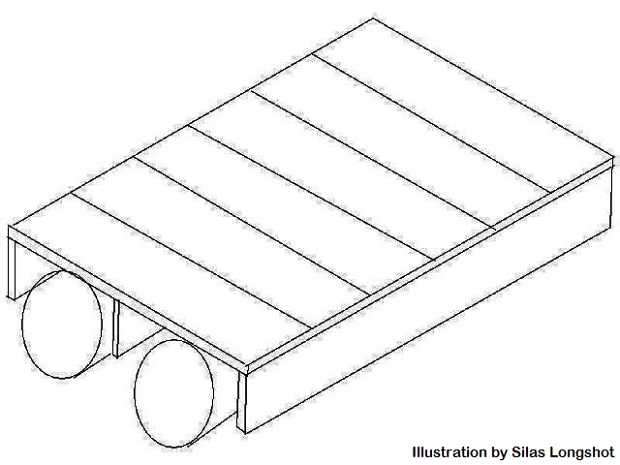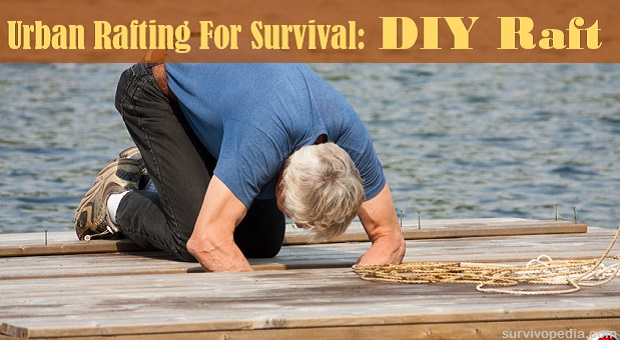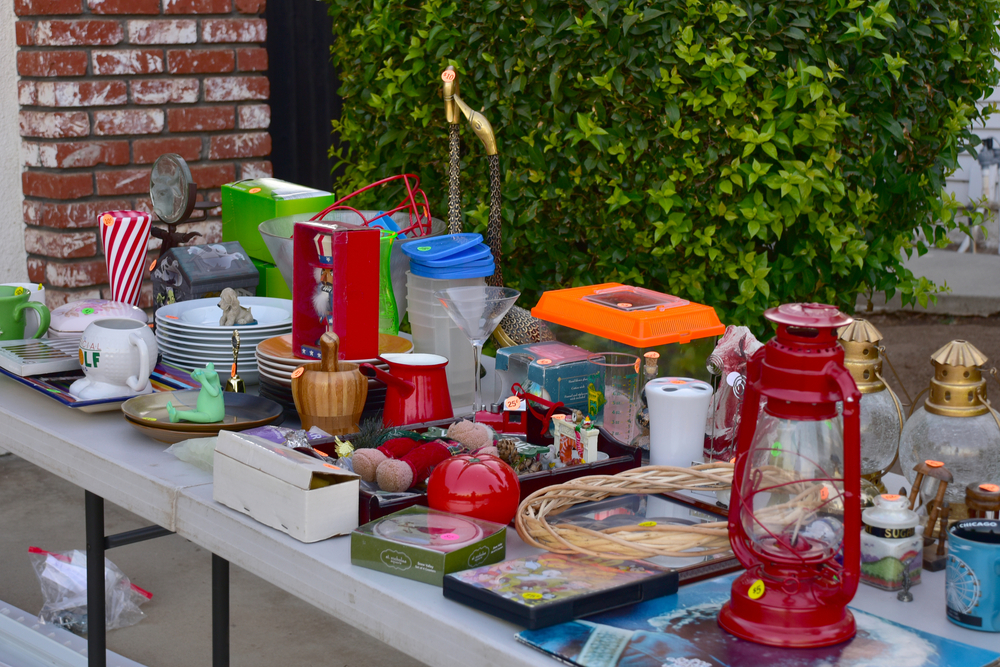Let’s start with the usual idea that we’re either preparing for a potential situation (which is what we’re all about here, right?) or you find yourself in the middle of a situation that needs to be addressed as surviving through it.
Pick any terrible event you can imagine where you feel it’s time to head to other places. And think about one alternate way to escape from the city, if any river is close by: rafting for survival.
When There Is No Road to Go
Let’s paint the usual bleak picture. The world economy has crashed or terrorists have knocked down the grid, the Ebola pandemic is totally out of control and Dallas, Pittsburg and Coopersville are under quarantine. Or the current administration has decided to remain in power through martial law.
Think about a grid down scenario. Use the expressway? Forget about it, it’s total gridlock, hundreds of fender benders where hapless people are waiting for the cops to show up to settle the insurance claim information… who will never show up.
Hundreds of unprepared people have sat in the gridlock with their vehicles running and are now out of gas. (If you ever find yourself in a gridlock situation, SHUT OFF your engine unless the traffic actually begins to move. Never mind the weather and your comfort. If it’s hot, roll down the windows. If it’s cold, then put on your jacket or get out your emergency blanket from the trunk.)
These cars will now sit here for months, since there’s no power to operate gas pumps to replace your fuel, nor for the good Samaritans who could bring you some.
The same effect will be happening on streets and roads, particularly where ever there is a natural bottleneck like bridges or underpasses or rivers where the traffic can not get past without the lanes being clear or passable between stalled or wrecked vehicles.
Now, you and your family are down to the most basic of transportation….your feet. You all have your backpacks stuffed with everything you think you may need. You should have made a list of what you really needed and had that packed in these bug out bags months ago.
You must remain on high alert at all times during your survival trek….there are hoards of desperate people just like you out there…but they will very likely not be nearly as nice as you are.
How to Build Your Own Raft
Among the many other alternate paths to get outta Dodge, like railway lines, power transmission line rights of way, gas pipeline rights of way, for instance, there is also the river, if close by. No boat? Ah! That’s what are we talking about: you could make a raft from typical suburban found materials.
In the back alleys of every shopping center or big box store in the country, you will find the basic building blocks for many urban survival scenarios, your friendly neighborhood cargo pallet. Other useful materials may be found in their dumpsters as well.
You will find cargo pallets useful for building shelters, getting you up off the ground, for firewood, and loads of projects where you need a few boards. They are “alternative material construction” which people have used even for building houses using pallets.
About four of these would start a nice, fairly stable raft for two adults and a couple kids, or another pair for every extra couple people. Now to make these things actually float and support more than their own weight, you’ll need something of high flotation effect, like empty plastic barrels with the plugs or bungs as they’re called, still installed or a very large find of Styrofoam blocks.

Starting with the most ideal flotation device, the barrels, lets get some construction ideas going.
For most plastic barrels to fit properly underneath a pallet, you will need to remove the bottom boards (as indicated by the arrow in the picture at the right) so that the pallet will tend to grip the barrels with the remaining upright spacers that connected the top and bottom levels of the pallet.
After you have removed the bottom boards, which could be used for paddles once you get the nails and sharp splinters out of the way, the pallets are placed so that the barrels are saddled by the pallets. See the picture below for illustration.

You will have to lash or bind the barrels to each pallet and each pallet to the other until you have a roughly square construction like so, with a barrel or two under each pallet. See the picture below for illustration. (These sketches are not to scale by any means, just a display of the concept.)

Since you may not be so lucky as to find the needed amount of barrels, you could tear apart sufficient numbers of pallets to fill underneath the ones intended to be the raft, with the amount of wood to get pretty good floatation. This would have to also be lashed in place, like the barrels, as shown here:

If you’re lucky enough to find Styrofoam blocks of sufficient size to substitute for the barrels, the raft will be considerably lighter. If you find a massive pile of Styrofoam peanuts and heavy duty trash bags that you can empty out, you can bag up the foam equally into the bags assuming they’re large and tough enough and of roughly equal size.
The bags full of peanuts will be a really good thermal barrier between yourself and the raft….bean bag chairs / beds, if you will. They would also come in handy for sleeping on at overnight stops on shore as you slowly float along as the peanuts are a great thermal barrier. And the peanut bags may prove useful as flotation devices if the raft suddenly sank or got capsized, by accident.
And of course, if you happen to find sufficient dry logs to lash together down near the river, you can make the classic Huck Finn log river raft.
This article has been written for Survivopedia by Silas Longhshot, from Surviving Urban Crisis.







































































Re using the river:
Unless you plan on following the river’s edge by foot, there’s just one problem with that.
Rivers flow from the mountains to the coast, and the idea most people have of “bugging out”, is to head for the mountains. Unless your bug out location is downstream from your city, or you attach an outboard to your raft to go upriver, you’ll be heading in the opposite direction.
Still, one way that a river could be useful is to allow you to simply leave your urban area, but once there, you would have to backtrack around the outside of your city to head in the right direction, up towards the mountains, if that is where your “safe haven” destination is.
Larger rivers have eddy currents that you can use to move up stream. You do need to be careful at the end of the eddies as there are swirling cross currents, etc. and you will need to pole and/or tow to the next eddy. Also as always watch out for snags, etc.
If it is large enough for regular boat traffic it probably has usable eddy currents, only question being are they where you can use them.
Per the Darwin Awards website one should always ask “what’s the worst thing that can happen?”.
A) the same traffic conditions that make you think you need the river will prevent you from getting to the river as well (when outbound lanes are blocked people WILL use the inbound lanes to go out)
B) you are unlikely to find all the materials you need at the river
C) it may be a more dangerous place while you’re there than the place you left
D) rafts are slow unless the flow is really calm (see “C”)
E) any possible snipers along the way will f’ind you to be sitting duck targets
F) once you make this choice you’re either on the river or on foot
So, IMO, I’d rather get an extra job now and outfit my vehicle with frame-mounted front and back collision bumpers that I could use to move those disabled cars, and to buy a large motorized canoe or flat-bottom boat if I had a good river nearby.
Sorry, but “D” was supposed to say that a raft is slow unless the river is fast, but hard to manage on anything that isn’t flat water.
Here’s a thought. Could you collect plastic milk jugs, fill with plastic peanuts, and then attach to the pallet with an electrical jip tie through the pallet slats to the handle of the jug.????
I’ve seen my little brother make a raft out of a radio flyer and four 2-liter bottles. I’m not saying it could hold him, but if you don’t have barrels, 2-liter bottles could be a viable option for flotation.
I happen to live about 100 yards from the inland waterway and my bugout destination is a friends secluded, rural home about 15 miles north on the waterway, then 8 miles east by land. I have bought a 17 ft. canoe, which I intend to load up with my supplies (some of which are already in place at my friend’s) and paddle to where I have to head east on foot. I have 2 small wheeled canoe “carts” which, after unloading the canoe and pulling it out of the water, will be strapped to the bottom of the canoe, one on each end. Then, after reloading my equipment back into the canoe, the 8 mile trek over land, on paved roads, begins with me acting as the mule pulling the load.
I happen to live about 100 yards from the inland waterway and my bugout destination is a friend’s secluded, rural home about 15 miles north on the waterway, then 8 miles east by land. I have bought a 17 ft. canoe, which I intend to load up with my supplies (some of which are already in place at my friend’s) and paddle to where I have to head east on foot. I have 2 small wheeled canoe “carts” which, after unloading the canoe and pulling it out of the water, will be strapped to the bottom of the canoe, one on each end. Then, after reloading my equipment back into the canoe, the 8 mile trek over land, on paved roads, begins with me acting as the mule pulling the load.
River’s not such a bad way here and only a couple of miles off. A viable option. Thank you for the idea. I believe we can camouflage it to look like floating refuse so as not to be a tempting target for “snipers”.
I made rafts like you are talking about when I was a kid, although we built them from scrap lumber…….didn’t have pallets. Either barrels or inner tubes work fine for flotation. As Jessica said, 2 liter bottles can also work in a pinch but gallon milk jugs are a better option. In general I would steer clear of Styrofoam for flotation if you plan on traveling very far……. low density foam, which is what is primarily used for insulation and packaging can soak up water and become waterlogged fairly quickly. 4 pallets joined together using 8 35 gallon barrels as shown will provide an effective payload of around 1,000 pounds. Properly distributed the raft could carry more than 2.000 pounds, but everything over 1,000 pounds has a detrimental effect on stability. A good rule of thumb is that you want at least half of your floatation above water with the raft loaded. Stability is important.
Transporting pallets and barrels to the river could be a problem. I would personally opt for an inflatable that could be loaded in or on the car, or carried in a pinch.
If you plan on using a river, know before you go. If you are just using the river to get you out of the city that is one thing, but if you plan on using it for the long haul then research the river. There may be rapids,waterfalls or dams…….. not something that you want to discover while peacefully drifting along a 2:00am. Also, take a float trip down the river before SHTF s that you can learn it first hand………it is a very pleasant and relaxing way to spend a day or two.
Now there is one thing that has been missed by all websites i’ve ever read.
In a SHTF scenario I guess we all assume that public transport will most definitely not be working but out of any major city these links exist.
I myself live in Taipei Taiwan but I am also a Brit so blending in here just will not happen.
Next door to my house is the High Speed Rail station that runs from here to the complete south of the country so IF I needed to get out I’d just walk the line.
This line could be walked at night through tunnels that take me out of the city into the countryside and onwards up on viaducts out of harms way the entire length of the country. Up there at night moving slowly and quietly with a point man and tail ender a group could cover lots of ground without incident. Anyway, It’s a option so don’t forget your subways people!
Chewy, that’s exactly what my link to ‘alternative paths’ referred to….there are many ways out of a situation that most people without the ‘prepper mentality’ may not think of initially. That would indeed include rail lines, along with power transmission line rights of way, natural gas line rights of way, etc. The utility rights of way would have an occasional obstacle to deal with like maybe a river or swamp to cross, and loads of private property fences to get over. As always, keeping alert as you travel is crucial.
This idea is a good idea if you know where you will end up and how long it will take.
But what if its in the winter with ice.
If the ice is thick and you have ice skates, it’s actually better, as long as you’re travelling light. With ice you can head upstream without any problems.
I think you would be a sitting duck on any open body of water. How do you protect yourself against armed criminals if the rule of law breaks down?
Lock and load.
The St Johns River in Florida is a very long one, about halfway up the east coast. It runs through Jacksonville, which could be a threat if the wheels come off everything. I’ve broached the possibility of teaming up with other boatowners to form a group to escape to the Bahamas…mutually supporting one another will insure safety from pirates as we run the gauntlet of Jacksonville.
You and your group should consider that the greatest “pirates” might be the Coast Guard and/or Navy.
In an SHTF situation they might be trying to enforce some sort of absurd lockdown, which would include shooting at anything that moves on or under water, as standard operating procedure. Especially some sort of “flotilla”.
In such a situation, they would not be asking questions.
First it seems you all have forgotten that paddles and poles can be used to move the raft, also on some rivers you can go upstream using eddy currents. As for making it look like junk it does not mean somebody might not shoot at it just because it there or for target practice.
First it seems you all have forgotten that paddles and poles can be used to move the raft, also on some rivers you can go upstream using eddy currents. As for making it look like junk it does not mean somebody might not shoot at it just because it there or for target practice. Then there’s the time of day just after sunrise or just before sunset may make harder to be seen.
Buy OR make your own Hoverwing. It’s a hovercraft (on land/water) that can fly like an airplane several feet over the ground using what’s called “ground effect” once it reaches a certain speed. Check out the youtube videos. This baby can be quickly dismantled for storage, and will get you out of any situation…land or water.